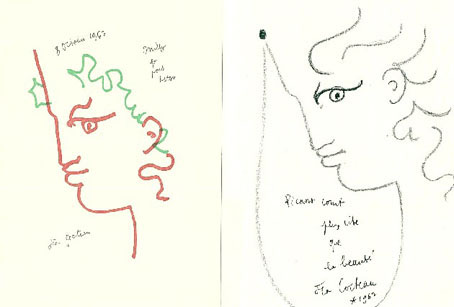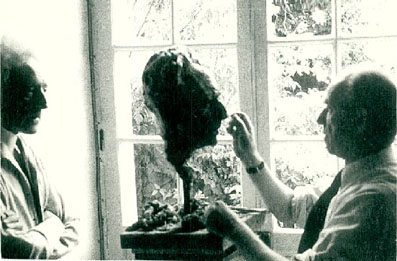Jean Cocteau at the
Centre Pompidou in Paris
Exhibition on the 40th
anniversary of his death in 1963

Young Orpheus for Arno Breker
and Pablo Picasso.
Left: Drawing by Cocteau,
dedicated two days before his death to Arno Breker. Fernand Mourlot
lithographed the design for a limited edition.
Right: Drawing with a
dedication to Picasso one year earlier.
© Cocteau-Archiv, Edouard Dermit/Maco-VG, Bonn
Germany
Paris (bpb) The Centre Pompidou
in Paris has dedicated an exhibition on the occasion of the 40th
anniversary of the death of Jean Cocteau.
The artist died of a
heart attack at age 74 at his chateau in Milly-la-Foret, France on
October 11, 1963 after hearing the news of the death of his friend,
the singer Edith Piaf.
The Centre Pompidou presents Cocteau (1889-1963)
as an extraordinary multi-talented person: the poet, writer, critic,
but also film director, drawing artist and player on the French
musical scene, from 1920 to 1963. The wealth of his many activities
is reflected in more than 1,000 works and documents on exhibition,
such as: 335 drawings, 300 photographs, 22 paintings by major artists
who celebrated him, 50 or so manuscripts, objects and sculptures.
Finally, within the exhibition, a projection room shows an anthology
of his films: Le Sang d'un poète, Orphée, Le Testament
d'Orphée, Les Enfants terribles, La Belle et la bête,
Les Parents terribles.
One part is missing in this retrospective
exhibition devoted to Cocteau: the political aspect of this
personality. 40 years after his death and 58 years after the
Nazi-times, the organizers of the exhibition did not take the care to
present an important aspect: the German occupation during World War
II. and the part Cocteau played in those times. After 1945 he was
criticized for his collaboration with the Nazis. But Cocteau used his
friendship with the German sculptor Arno Breker to protect Pablo
Picasso in Paris. Both intervened on the behalf of Picasso, who was
caught by the German Secret Police (Gestapo), because of his support
of the communist party.

Jean Cocteau is posing in his
house a Milly-la-Foret for the bust, created by Arno Breker in 1962.
Cocteau and Breker were reminiscencing about Pablo Picasso and the
time of German occupation of
Paris. By cooperating
with Breker, Cocteau helped to save Picasso from the German Secret
Service Police (Gestapo). They had Picasso under surveilance, because
of his financial support of the Communist Party in those
days.
© Cocteau-Archiv EKS, Marco-VG Bonn
Eyewitness miss in this exhibition the bust of
Jean Cocteau, which Arno Breker created in 1962 and the sculpture
"The Prophet". This bronze shows Cocteau in the year of his death.
The bust by Breker is since 1963 on the grave of Cocteau.
The exhibition Jean Cocteau is held at Centre
Pompidou from September 25th to January 5th 2004. (The French editor
Gallimard is publishing a book on Cocteau).
There are several other
exhibitions to honoring Cocteau:
1. Jean Cocteau: Universal
Creator. May 6, 2004 to August 29, 2004, Montreal Museum of Fine
Arts, Montreal.
2. Jean Cocteau and Arno
Breker, sculptures and erotic drawings and graphic works, Museum
Europäische Kunst, Noervenich/Germany (museum@europaeische-kultur-stiftung.org)
3. By the Hand of Jean Cocteau:
September 2, 2003 to January 23, 2004, Hofstra Museum, Hempstead
NY.
Copyright 2003 West-Art, Prometheus
89/2003
Keep informed - join our
newsletter:
Copyright 2003 West-Art
PROMETHEUS, Internet Bulletin for Art, Politics and
Science.
Nr. 89 Fall 2003